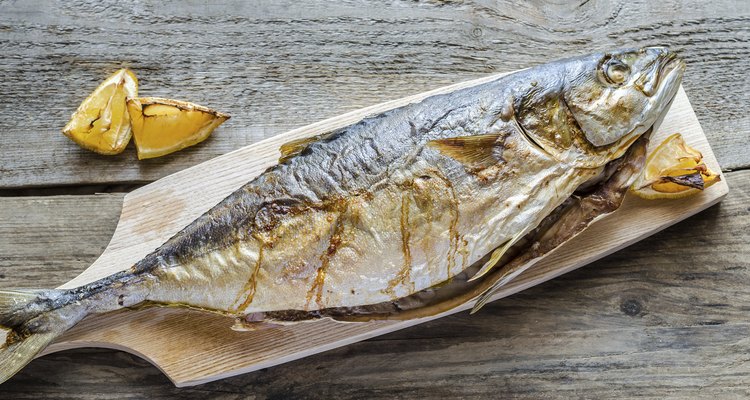
AlexPro9500/iStock/Getty Images
California's yellowtail is often misidentified as a small tuna, which might be maddening to marine biologists but makes perfect sense to cooks. Like tuna, yellowtail has a firm, meaty texture and is rich in natural oils. This gives cooks a great deal of flexibility, because -- unlike many common food fish -- yellowtail is robust enough to stand up to grilling, and to rich sauces and seasonings. It even lends itself in some cases to slow-cooking, a rarity in the fish world.
Grilled Yellowtail
Yellowfish fillet portions grill well, especially -- though not necessarily -- with the skin on. Brush them on both sides with oil, then season them as you wish with spices or fresh herbs. Start them skin-side up, until the flesh becomes golden brown, then flip them and cook until the skin is crisp and they're just barely translucent in the thickest areas. Alternatively, cut the fillets into thin strips and brush them with teriyaki sauce, or a mixture of soy, lemongrass and ginger, and grill them quickly until just done.
Yellowtail in a Pan
Like true tunas, yellowtail can also be served while rare or medium-rare. That's often done in a pan, where direct, searing heat quickly gives the yellowtail a savory golden crust. Sear it skin-side up, initially, then flip to crisp the skin as well. It can be cooked very simply, with no additional preparation, or crusted with sesame seeds, chia seeds, crushed nuts or a mixture of coarsely ground spices. When sliced, the dark crust makes an eye-catching contrast with the rare flesh inside.
Braised Yellowtail ‘Collar’
Yellowfin is known as hamachi in Japanese restaurants, where it's much loved. Aside from its role in sashimi, the yellowfin yields a thick, bony "collar" where its fillets were attached to the fish's gill plate. The meat attached to this bone is especially choice and stands up to slow-cooking. Crack your collars into two or three pieces, and simmer them for an hour or two in a cooking broth of water with sake, mirin, soy and ginger. The buttery-soft flesh pulls easily from the bone. Collars can also be grilled, for an equally satisfying but quicker meal.
Clear Conscience
If you try diligently to make ethical shopping choices, yellowtail is a good option compared to many better-known fish. Seafood Watch advises consumers to avoid the farmed product from Japan and Australia, but the domestic product can be purchased with a clear conscience. Handlined yellowtail from California and Mexico is a "Best Choice" in the Seafood Watch ratings, while gillnetted yellowtail is a "Good Alternative."
Related Articles

How to Pan Sear Sea Bass

How to Cook Cobia

Can You Eat the Skin on Grilled Trout?

How to Cook Walleye by Broiling

How to Pan-Sear Swordfish

How to Cook Kingklip

How to Cook Redfish on a Grill

How to Cook Moonfish

How to Cook Monchong Fish

How to Cook Fresh Walleye

How to Cook Seasoned Keta Salmon

Is There a Way to Cook Tuna Steaks on ...

How to Cook Squab

How to Cook Tilefish

The Best Ways to Cook Pheasant Breast

How to Pan Fry Grouper

How to Cook Sailfish

How to Grill a Mahi Mahi Fillet

How to Cook Tilapia With Orange Juice & ...

How to Cook Ono Fish
References
Writer Bio
Fred Decker is a trained chef and prolific freelance writer. In previous careers, he sold insurance and mutual funds, and was a longtime retailer. He was educated at Memorial University of Newfoundland and the Northern Alberta Institute of Technology. His articles have appeared on numerous home and garden sites including GoneOutdoors, TheNest and eHow.
Photo Credits
AlexPro9500/iStock/Getty Images